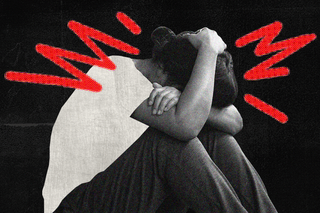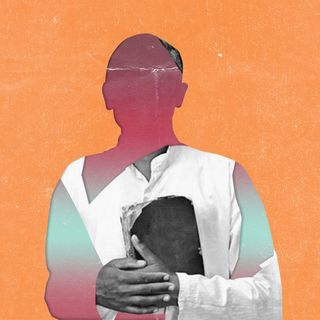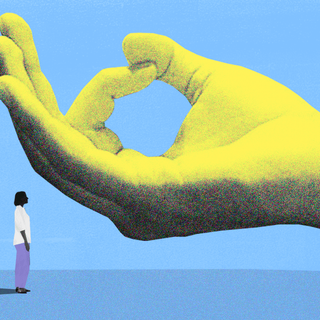
All You Need to Know About Complex PTSD
“Hypervigilance and startle response are big issues for me. I’m constantly scanning to make sure everything’s safe.”

“Hypervigilance and startle response are big issues for me. I’m constantly scanning to make sure everything’s safe. I can’t sit with my back to a door, and if I do, it’s on my mind that there could be danger,” Kate G. told The Mighty in 2019 about the experience of living with C-PTSD. “Loud noises startle me easily… Last year, [the Fourth of July celebration] was so bad I came home, turned the music as high as I could, and just started screaming and sobbing. I couldn’t handle it,” G. added.
C-PTSD, or complex post-traumatic stress disorder — also called complex trauma disorder — is a result of prolonged exposure to trauma. While PTSD generally follows a single traumatic event, C-PTSD is often a result of repeated trauma — especially, if one saw no way to escape the traumatic situation. Being subjected to constant bullying or ostracization as a child, experiencing neglect or abandonment, witnessing repeated domestic violence or abuse, suffering intimate partner abuse, or having one’s lived experiences invalidated over and over again are things that can put people at a greater likelihood of developing C-PTSD.
While anyone can develop C-PTSD, experts note that people with underlying mental health conditions, or a family history of it, maybe more vulnerable. Similarly, how individual brains regulate “hormones and neurochemicals, especially in response to stress,” can determine one’s propensity to acquire C-PTSD too — as can the lack of a strong support system.
Research suggests that 7.3% of all humans may develop PTSD and C-PTSD in their lifetimes — between the two, the prevalence rate of PTSD was deemed at 4%, and that of C-PTSD was 3.3%.
Yet, the DSM-5, or the fifth (and latest) edition of the Diagnostic and Statistical Manual of Mental Disorders published by the American Psychiatric Association in 2013, doesn’t include C-PTSD as an official diagnosis yet. Unlike the DSM-5, however, the ICD-11, or the eleventh revision of the International Classification of Diseases published by the World Health Organization in 2018, recognizes C-PTSD as a “disorder.” The neurodiversity movement — that roots for society to see autism, ADHD, and OCD, among others, as a divergence from being neurotypical, rather than as a “health condition” — recognizes C-PTSD as neurodivergence too; albeit an acquired one.
Related on The Swaddle:
Children Who Experience Violence or Trauma Age Faster: Study
C-PTSD manifests pretty much the same way PTSD does — except, with additional symptoms. The traits it shares with PTSD include reliving traumatic events in the form of flashbacks or nightmares; avoiding reminders of trauma — be it certain sounds, settings, or people; and being hyper–reactive to stimuli, or being hyper–vigilant because of a constant perception of threat.
The additional symptoms that C-PTSD induces range from emotional dysregulation, like “feelings of anger [for instance] seem[ing] overwhelming and difficult for the person to manage,” as David Berle, a clinical psychologist and associate professor at the University of Technology Sydney, wrote in The Conversation. A negative sense of self dominated by notions of shame, guilt, or worthlessness; feeling disconnected from others; or struggling to communicate one’s thoughts and emotions effectively are a few other ways in which C-PTSD manifests. In addition, C-PTSD symptoms may also include experiencing somatic symptoms like headaches, chest pains, or dizziness. According to the NHS, C-PTSD can also manifest as “destructive or risky behavior” like self-harm or substance abuse — and even suicidal thoughts.
The manifestations of C-PTSD can also vary across ages — experiencing it in childhood, for instance, can lead individuals to develop disorganized attachment styles. According to the ICD-11, C-PTSD can present differently across cultures too, and even be exacerbated depending on one’s social identity. “For migrant communities, especially refugees or asylum seekers, [C-PTSD] may be exacerbated by acculturative stressors and the social environment in the host country,” the manual states.
It may also be pertinent to note that according to the ICD-11, female individuals are more vulnerable to C-PTSD than their male counterparts. Not only that, but the former set also has a higher likelihood of exhibiting “a greater level of psychological distress and functional impairment.” Large-scale gender-diverse data — capturing vulnerability to C-PTSD across the gender spectrum — unsurprisingly, remains absent.
Unfortunately, however, many mental health professionals continue to be unaware of C-PTSD, which not only makes diagnosis more difficult, but also makes people living with it feel misunderstood. “The first psychotherapist I went to advertised that he was trauma-informed, so I thought it would be a good fit. I confided in him and reported my symptoms… I was told that I needed a mood-stabilizing drug and that it was looking like I had [Borderline Personality Disorder (BPD)]. I was left that office very frustrated, feeling as though he didn’t truly listen to me and try to understand what I was dealing with, but instead jumped to a diagnosis,” Traci Powell, who lives with C-PTSD, wrote in 2019. Unfortunately, Powell’s experience, while heartbreaking, isn’t unique. Many like Powell are misdiagnosed with BPD — forcing them to go through unwarranted medication and the prolonged misery of not receiving treatment for their condition, while continuing to feel isolated in their experience.
“After trying the drugs and feeling much worse, a friend convinced me to try another therapist… She took her time getting to know me for weeks before she suggested any diagnosis, and when she finally did, it was complex PTSD. As she explained what it is to me, I sobbed. Finally, someone understood me and, even more, I finally understood myself,” Powell continued.
Related on The Swaddle:
Repeated Exposure to Trauma Does Not Make People Stronger, Shows New Study
C-PTSD may warrant long-term, intensive support — perhaps, even longer than traditional PTSD — but it is treatable. “At times I felt nothing was going to end the distress, experiencing more than 10 flashbacks a day… It was a long process of recovery, with lots of bumps along the road, but the right medication and long-term therapy with someone I came to trust, has changed my life,” an individual living with C-PTSD had told Mind, a mental health charity in England and Wales, last January.
Treatment for C-PTSD may involve a combination of approaches — including both psychotherapy and medication. According to Mind, one may simultaneously need support for other existing conditions like depression and dissociation, too.
But when it comes to treating C-PTSD per se, often treatments recommended for traditional PTSD are employed. This includes trauma-focused therapy, which “involve[s] a systematic recall of the trauma memory in a safe and controlled way,” as Berle explains. Mental health professionals may engage in trauma-focused CBT (cognitive behavioral therapy) or DBT (dialectical behavioral therapy) to treat people living with C-PTSD.
Taruna Jamalamadaka, DClinPsy, a clinical psychologist from the UK, who practices trauma-focused CBT had told The Swaddle last year that when we experience trauma, its memories are not stored in the way regular memories are. In general, memories are filed away in the hippocampus of the human brain — sorted based on context, that is, by date, time, and place of occurrence. Traumatic experiences, on the other hand, are stored in the amygdala, mostly in the form of fragmented, sensory memories in the amygdala, which can be triggered by sights, smells, and sounds. Trauma-focused therapy works by helping a person process these traumatic memories — that are causing them dissociation, flashbacks, or nightmares — in a manner that they get filed contextually in the hippocampus like regular memories.
While professionals have developed different approaches to treat people dealing with C-PTSD, there continues to be some debate on whether treatments meant for traditional PTSD can necessarily help people with C-PTSD. As Berle noted, “Discussions about diagnoses can seem far removed from the lived experience of people who have experienced trauma. Diagnostic systems are based on research, but they are products of committees of stakeholders with a wide range of viewpoints.”
Perhaps, with growing awareness of C-PTSD, there will be more research on treatment options for individuals. Until then, petitions to have it recognized in the DSM will probably continue to circulate — perhaps, in the hope of greater awareness of the condition among mental health professionals, if not just for better-researched treatment options.
Devrupa Rakshit is an Associate Editor at The Swaddle. She is a lawyer by education, a poet by accident, a painter by shaukh, and autistic by birth. You can find her on Instagram @devruparakshit.
Related


How I Have Sex: ‘Sex is Not Salvation, Marriage is Not Heaven, and Singleness is Not Hell’
